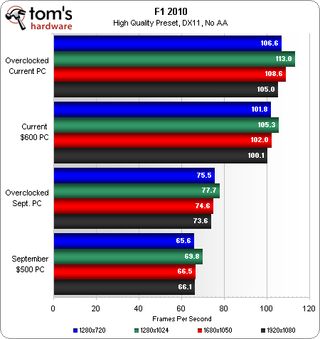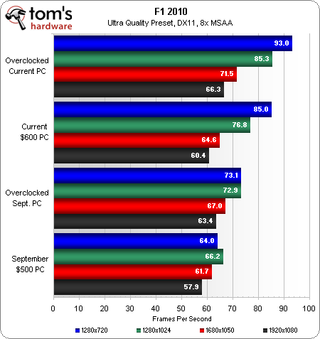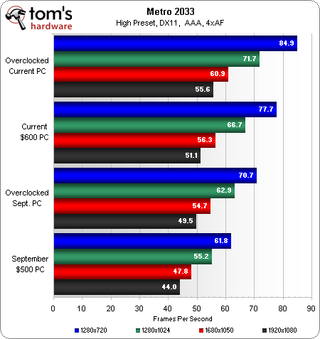System Builder Marathon, Dec. 2011: $600 Gaming PC
Benchmark Results: F1 2010 And Metro 2033

F1 2010
While it establishes a pronounced lead over AMD's Phenom II, even the Core i5-2400 becomes a bottleneck when we start looking at games that tend to rely on CPU horsepower.


Ultra details and 8x MSAA introduce a demanding-enough graphical load to bring the systems closer together as resolution goes up. But it's important to note that all of these configurations are still capable of a maxed-out 1920x1080 experience.
Metro 2033
Clear scaling by resolution indicates a graphics limitation, even at the High quality preset (our low test setting). The current PC leads the former at all resolutions, indicating that our change of CPU (or maybe the graphics driver) is coming into play, too.


We turn on all of the eye candy, aside from Advanced PhysX, for this second test set, including the highest detail levels, 4x MSAA, and the frame rate-zapping Depth of Field (DoF) filter.
At our lowest tested resolution, these settings are a bit overwhelming for an overclocked Radeon HD 6870. While playing through the game's prologue, frame rates dipped into the mid 20s, which is low for a shooter.
Current page: Benchmark Results: F1 2010 And Metro 2033
Prev Page Benchmark Results: Crysis And Just Cause 2 Next Page Benchmark Results: Audio And VideoStay On the Cutting Edge: Get the Tom's Hardware Newsletter
Join the experts who read Tom's Hardware for the inside track on enthusiast PC tech news — and have for over 25 years. We'll send breaking news and in-depth reviews of CPUs, GPUs, AI, maker hardware and more straight to your inbox.
-
Probably the best bang for buck build compared to the $2400 and $1200 PC. I remember seeing Anandtech using the A8 series with integrated gpu for their $500/600 build. This looks much better for gaming.Reply
-
compton The 2500K is really worth the extra cash over the 2400, but only if you purchase a Z68 or P67. For gaming, you might be better off with an i3 and putting the remainder towards a faster GPU as suggested in the conclusion.Reply
For the price, the 2500K + a P67 or Z68 is unbeatable and certainly worth breaking the budget over. But for SBM, I can see why going the 2400 plus H61 route makes sense.
Personally, I would have preferred to see a cheaper motherboard and CPU config with an SSD (instead of the mechanical storage). It wouldn't have scored as well, but I can't get by without an SSD as easily as I could a slower processor.
I wanted the $500 build to get bumped up to $600, but that was to add a SSD so that each SBM machine could have some solid state action.
-
slicedtoad i might be missing something but on the just cause 2 chart:Reply
Enabling 8xAA at the highest detail levels pushes our graphics hardware, and this quarter's machine is unable to beat the former rig running at 3.8 GHz, even at our lowest resolution.
The chart seems to indicate that the current machine did beat the former... though perhaps not by alot. -
slicedtoad ReplyStepping down to a more affordable Sandy Bridge-based Pentium or Core i3-2100 would facilitate a GeForce GTX 560 Ti or Radeon HD 6950 at the same budget level.
So would a 6950 + i3 give better performance in games @ 1080x1920 than this build? -
lancelot123 I must be lucky that I can get 2500K for $180 around here. Cheaper than the 2400 they have in this.Reply -
doron Replyin order to win, the December PC needs to make up for mark-ups on the hard drive and video card, as well as the additional cost of a more feature-rich motherboard.
Definitely a kick-ass machine, but imo this line is simply wrong and misleading.
If you factor out today's and September's cpu and motherboard, the difference between the rest of the parts is a mere 8$. Furthermore, with only 2 dimms and no overclocking capability whatsoever I really can't see how you can call this MSI board a more "feature-rich" than September's ASRock.
The way I see it, today's and September's machines are in two different price segments, and at this low budget, pouring an extra ~90$ can actually give you a lot. For example, given today's system, if we take out the cpu, motherboard and gpu, we will be able to fit inside a Phenom II x4 960T (125$), some 60$-70$ motheboard, an hd6950 1gb gpu, and probably still have room for a 20$ HSF. Talk about value.
I'm not trying to defend amd here or anything, It's just that a lot of times people come to me asking for advice on what computer to get, and I can fairly confidently say that when someone wants a 4 core sandy bridge at this budget, I'll say to him that I won't help and tell him to go find a deal somewhere because in my eyes, getting a cpu that's 1/3 of your budget only to be able to get an extra minute or two in every benchmark or getting high fps in low resolutions, is too much of a compromise in every other component.
